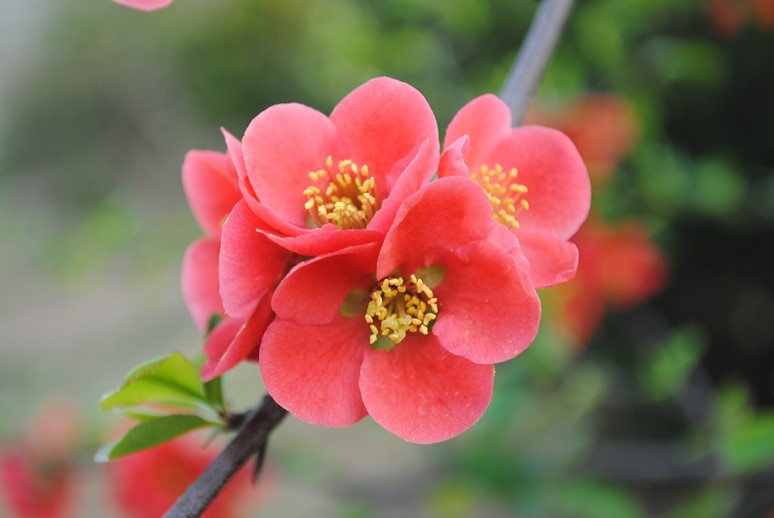Phylogentic tree of all flowering plants
Flowering plants (angiosperms) are one of the most diverse organismal groups on earth. They dominate in most terrestrial ecosystems and serving as both major food source and habitat for many other organisms. Because of their major impact on terrestrial ecosystems and other organisms, understanding the temporal and spatial patterns of their diversity and diversification are curtail in order to address the general process that drive species diversity and distribution in general.
About the study
We used a complete dated phylogeny of flowering plant genera and global dataset on their distribution to study flowering plants diversification and distribution patterns through space and time.

Chaenomeles japonica (Rosaceae) Location: Beijing, China (30m) Photo: Nawal Shrestha
Phylogeny of flowering plant genera
To build our phylogentic tree of all flowering plants genera we took advantage of publicly available resources such as GenBank.
Because of the shear amount of sequence data that is now hosted at GenBank we used a sophisticated algorithm to extract and evaluate the quality of the DNA sequence data that was used to build our molecular phylogenetic tree.
OneZoom phylogeny and resource browser
The tree used in the analyses presented in the main text of our manuscript can be explored here using the OneZoom tree visualization tool. The tree browser provides also links to additional information from various open access online sources such as Wikipedia and the Encyclopedia of Life. This rich additional content makes it also a great tool for educational purposes. In addition the tree topologies in newick format are also available thought the links on the right of this page.
We used the information from the fossil record to date our tree and a polytomy resolver to add the taxa that were not represented in our DNA data matrix.
Data sources
To construct the global distribution of flowering plants, we compiled more than 1,300 data sources, including published floras, herbarium specimen records, online databases, and other botanical literature.
The main data sources are:
- Plants of the world online (http://www.plantsoftheworldonline.org/)
- Catalogue of Life annual-checklist 2018 (http://www.catalogueoflife.org/annual-checklist/2018/)
- eFloras
- Kew's data and resources concerning plants (https://www.kew.org/science/data-and-resources/plants)
- Tropicos (http://www.tropicos.org/), Missouri Botanical Garden's electronic databases during the past 30 years
- The Internal Legume Database & Information Service (ILDIS, http://ildis.org/)
- Global Biodiversity Information Facility (GBIF, https://www.gbif.org/)
- The Angiosperm Flora of India (beta version, http://flora.indianbiodiversity.org/)
- The Euro+Med PlantBase (http://www.emplantbase.org/home.html), an on-line database and information system for the vascular plants of Europe and the Mediterranean region
- National Specimen Information Infrastructure (NSII, http://www.nsii.org.cn), including over 6 million digitized plant specimens of China.
- Flora Reipublicae Popularis Sinicae.
- Chinese Virtual Herbarium (CVH, http://www.cvh.ac.cn/), including digitalized provincial floras of China.
- The PLANTS Database (https://plants.usda.gov/) provides standardized information about the vascular plants, mosses, liverworts, hornworts, and lichens of the U.S. and its territories.
- African Plant Database (http://www.ville-ge.ch/musinfo/bd/cjb/africa/index.php?langue=an), including distribution maps for over 50,000 species of Africa.
- Flora of U.S.S.R. (vol. 1-30)
- CANBR and ANBG databases (https://www.anbg.gov.au/cpbr/databases/), including all botanical databases of Australia.
- Flora do Brasil 2020 (http://floradobrasil.jbrj.gov.br/), including province level distribution of over 30, 000 angiosperm species in Brazil.
- Other data sources (link to the page of whole data sources list).
In addition to data already available in digital format, we directly digitized records from numerous printed regional and local floras. The taxonomic nomenclatures of different sources were standardized according to The Plant List and the Catalogue of Life annual-checklist 2018.
Citation
XX !!We just add the citation here and we also add the citation to the right of the pag XX !!
Download data
Additional data and resources are available here.
Download all data in one zip file.
The distribution data is available upon request from the authors. Please contact the corresponding authors for further details.
Contact Information
Dr. Zhiheng Wang
Assistant Professor
Department of Ecology,
College of Urban and Environmental Sciences
Peking University
Assistant Professor
Center for Macroecology, Climate and Evolution,
Natural History Museum of Denmark,
University of Copenhagen
Mailing address: Yifu #2 Building, 5 Yiheyuan Road, Haidian District,
Beijing 100871, China
E-mail: zhiheng.wang@pku.edu.cn
Tel: +86-10-136-8132-8081
Google Scholar: https://scholar.google.com/citations?user=aU3Ag4MAAAAJ&hl=en
Group website: http://www.macroecology-pku.org

